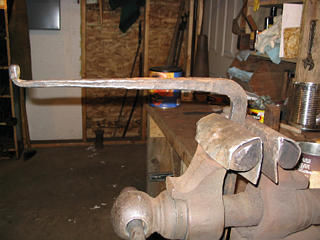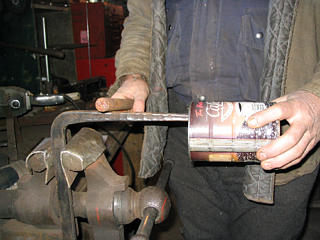

 This one is forged from 1/2" x 1" mild steel. It might work better if
it were made thinner and from a more springy steel.
This one is forged from 1/2" x 1" mild steel. It might work better if
it were made thinner and from a more springy steel.
I read somewhere that using an iron bar instead of an ordinary hammer
to strike the tool makes things easier. That seems to be true because
you don't have to think about the orientation of the hammer.

The working end of the tool should be smooth but not polished. If it's polished, it makes it harder to keep it positioned just where you want it inside the workpiece. It will tend to slip too easily off of high spots – low spots, that is, as seen from the outside.
After finding the sweet spot on the "hammer" and on the tool, press the workpiece firmly against the working end and give the tool a snappy blow. A ding should appear in the workpiece, pushed up from the inside. The coffee can shown now has a nice little ridge around it near the bottom. I'll finish forming it into a Baroque teapot when the weather's warmer. :-)
Disclaimer: This is a hack. It could work better than it does, maybe much better. Anyone who has some good experience with these things should emerge from lurk mode on TheForge and tell me – us – all the tricks I don't know.